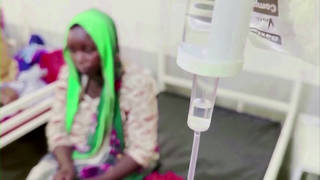
In a devastating new report, Oxfam says one person is likely dying from hunger every 48 seconds in drought-ravaged Ethiopia, Kenya and Somalia. We speak with Shannon Scribner, director of humanitarian work at Oxfam America, about how the hunger crisis has worsened since an earlier report was released 10 years ago. She says climate change and the recent war in Ukraine have worsened already dire conditions in East Africa. Researchers have been warning for years that drought and famine would be on the horizon, says Scribner. “We really need a system that is more responsive to those early warnings.”
Transcript
AMY GOODMAN: This is Democracy Now!, democracynow.org, The War and Peace Report. I’m Amy Goodman, with Nermeen Shaikh.
The president of Senegal, Macky Sall, who chairs the African Union, has warned the European Union that Africa is facing a food crisis with soaring wheat, fertilizer and energy prices combined with increasing food shortages due to the war in Ukraine. Russia and Ukraine are the largest wheat exporters in the world. During an address on Tuesday, Sall also criticized Western sanctions on Russia, saying they’re making it harder for African nations to buy food. The African Development Bank says the price of wheat has already jumped 45% on the continent. And the hunger crisis is being felt across the globe, from Afghanistan to Yemen to Ethiopia.
We’re joined now by Shannon Scribner. She leads Oxfam America’s humanitarian work. Last month, Oxfam released a report with Save the Children and the Jameel Observatory titled “Dangerous Delay 2: The Cost of Inaction,” which found a person is likely dying of hunger every 48 seconds in drought-ravaged East Africa.
Shannon Scribner, if you can talk about the extent of the catastrophe?
SHANNON SCRIBNER: Absolutely. Thank you so much for having me. So, this “Dangerous Delay” report, which is the second report — we did a previous report almost 10 years ago, and that was during the 2011 Horn of Africa drought, where 260,000 people died, half of which were children. And right now in East Africa, across Kenya, Somalia and Ethiopia, we are on track for 350,000 Somali children to die. So we are actually worse off than we were 10 years ago, and that sobering statistic of every 48 seconds, one person across Ethiopia, Somalia and Kenya is dying of hunger today.
NERMEEN SHAIKH: Shannon, could you explain what the different causes are for this crisis, from the pandemic to the war in Ukraine and the climate crisis?
SHANNON SCRIBNER: Absolutely. So, we know that the pandemic, over the last two years plus, has had a huge impact just globally and in East Africa, in particular. It also has caused prices, inflation to skyrocket. It’s caused the supply chains to be interrupted. But we’ve also had the driest season on record in East Africa. And we knew this two years ago, because we have early warning systems that are telling us a drought is coming, the rains are failing, malnutrition is skyrocketing. So we knew this two years ago. And then we have the conflict in Ukraine that has really exacerbated the crisis in East Africa, as well as West Africa and other places, because of the Black Sea exports that are so important to this part of the world, and wheat especially, that’s exported from Ukraine and Russia, that is impacting — impacting an already exacerbated food crisis.
NERMEEN SHAIKH: Shannon, as you mentioned, of course, the blocking of the ports in Ukraine is, in part, in large part, responsible for the crisis. The other issue, though, insofar as other wheat producers are concerned — among them, France, India and the U.S. — these countries are facing massive droughts, which will or have already resulted in wheat shortages. So, could you talk also about the impact or elaborate on the impact of that, not just the fact that Russia and Ukraine’s wheat exports are vastly diminished, but also what’s happening as a result of the climate crisis in other wheat-producing countries?
SHANNON SCRIBNER: No, absolutely. I mean, to stick to the report and East Africa and these countries, so, two years ago, we started hearing about food insecurity because of the drought. We knew that three consecutive rainy seasons had failed. Just in April, we know — we’ve heard that the fourth rainy season will fail. So there are early warning systems that tell us when a drought is on the horizon. It will tell us when malnutrition is spiking.
And so, the communities that we’ve been talking to in those countries are saying, you know, their life is worse off because of the climate crisis. They’ve had to leave their farms that they can no longer grow anything from, and they’re living in internally displaced camps. We have people whose animals are dying. So, we had one woman in Somalia who had 150 cows, and she has two cows left. And this is the story that we’re hearing across the countries. And now people are worried not just about their animals dying, but they’re worried about their neighbors and their family and their friends dying because of the famine-like conditions.
We also know that this is an extreme time and it’s an extraordinary time — right? — with the pandemic, but also with the conflict in Ukraine. But we are on track, by 2030, to actually have 560 disasters a year. And that is related to climate change. So, I don’t know if this is extraordinary times. So we really need a system that is more responsive to those early warnings, that we’re investing in those early warnings. We need to act when they give us the information that a drought is coming, that malnutrition is rising and that animals are dying. And we’re not doing that today.
AMY GOODMAN: Shannon Scribner, Oxfam released a report recently that a new billionaire has been created every 30 hours since the start of the pandemic, while a million people could fall into extreme poverty in 2022 alone. Can you talk about this and also the language that’s used? We now say things like “food insecure.” What does that mean? Why aren’t we saying “hunger” and “famine” straight out?
SHANNON SCRIBNER: So, the report that you’re referring to is called “Profiting from Pain,” and it’s talking about the 20 million people that have died as a result of the pandemic. And over those two years, when we’ve had so many people dying, we’ve seen an extreme inequality gap between those that are getting richer and those that are getting poorer. So, the quotes of the billionaires and how many people are falling into extreme poverty are really striking at this moment in our history.
And what we’re finding is, in East Africa, for example, it’s not that people are working less hard. They’re working more hard. They are, you know, walking for miles to try to find water, trying to find a pasture or food for their animals. They are doing everything they can to keep their families alive. They are skipping meals, often one meal a day, and sometimes the parents aren’t eating. We know that women are eating less or not at all, and they’re also preparing any meals that they can find, and they’re also responsible for finding those meals. So, the billionaires aren’t working harder. It’s because of the circumstances of the pandemic that they’ve been able to make a lot of money.
And so, we really need to think about that, when we have — right now in East Africa there is a humanitarian assistance, it’s at $4.4 billion. But we only have 3% of the funding. We have funding going to Ukraine, but not to places like East Africa.
And in terms of extreme hunger, you know, there is a classification that looks at malnutrition. It looks at water that’s available in houses. It looks at how many meals people eat a day. So there’s all these factors that it looks at. And it determines where it is. Is it extreme hunger? Is it famine? And it’s called IPC 1, 2, 3, 4, 5. And right now in East Africa, we are in 3, 4 and 5, and 5 is famine. So those are the emergency categories based on people’s access to food, based on availability of clean water and based on the number of calories they’re able to take in a day.
AMY GOODMAN: Well, Shannon Scribner, we thank you for being with us, leading Oxfam America’s humanitarian work.
That does it for our show. Democracy Now! is produced with Renée Feltz, Mike Burke, Deena Guzder, Messiah Rhodes, Nermeen Shaikh, María Taracena, Tami Woronoff, Camille Baker, Charina Nadura, Sam Alcoff, Tey-Marie Astudillo, John Hamilton, Robby Karran, Hany Massoud. I’m Amy Goodman, with Nermeen Shaikh. Stay safe.












Media Options